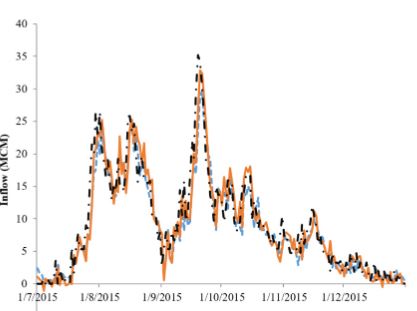Improving model using estimate error for daily inflow forecasting
Main Article Content
Abstract
Inflow forecasting is one of the important components for reservoir operation and resource management. To obtain enhanced accuracy for forecasting reservoir inflow, this paper proposed an improved model for forecasting the inflow of Bhumibol reservoir. The 3,169 records of daily inflow data from June 1, 2008, to February 1, 2017, had been collected to calculate the inflow into the reservoir by using Artificial Neural Networks (ANN) Back-Propagation Learning Algorithm for forecasting the inflow of the reservoir in the main model and error prediction model. The performance of the model can be evaluated by four methods: the coefficient of determination (R2), the Nash-Sutcliffe efficiency (NSE), the Root Mean Square Error (RMSE) and the Mean Absolute Error (MAE). Thus, these proposed main and error prediction models were combined to support the forecast of reservoir inflow. The performance of the proposed model can be evaluated by following measured values: R2 was 0.927, NSE was 0.925, RMSE was 6.805 and MAE was 3.611. This indicates that the improved model provides more accurate value.
Article Details

This work is licensed under a Creative Commons Attribution-NonCommercial-NoDerivatives 4.0 International License.
References
L. M. Lima, E. Popova and P. Damien, “Modeling and forecasting of Brazilian reservoir inflows via dynamic linear models,” International Journal of Forecasting, vol.30, no. 3, pp.464-476, 2014
C.T. Cheng, Z.K. Feng, W.J. Niu and S.L. Liao, “Heuristic methods for reservoir monthly inflow forecasting: A case study of Xinfengjiang reser- voir in Pearl river, China,” Water, vol.7, no. 8, pp.4477-4495, 2015.
Y. Bai, Z. Chen, J. Xie and C. Li, “Daily reser- voir inflow forecasting using multiscale deep fea- ture learning with hybrid models,” Journal of hy- drology, vol.532, pp.193-206, 2016.
C. Srisawat and J. Payakpate, “Comparison of MCDM methods for intercrop selection in rub- ber plantations,” Journal of ICT, vol.15, no. 1, pp.165-182, 2016.
M. Valipour, M. E. Banihabib and S. M. R. Be- hbahani, “Comparison of the ARMA, ARIMA, and the autoregressive artificial neural network models in forecasting the monthly inflow of Dez dam reservoir,” Journal of hydrology, vol.476, pp.433-441, 2013.
M. E. Banihabib, A. Ahmadian and F. S. Ja- mali, “Hybrid DARIMA-NARX model for fore- casting long-term daily inflow to Dez reservoir using the North Atlantic Oscillation (NAO) and rainfall data,” GeoResJ, vol.13, pp.9-16, 2017.
H. Moeeni and H. Bonakdari. “Forecasting monthly inflow with extreme seasonal variation using the hybrid SARIMA-ANN model,” Stochas- tic environmental research and risk assessment, vol.31, no. 8, pp.1997-2010, 2017.
K. l. Hsu, H. V. Gupta and S. Sorooshian, “Artifi- cial neural network modeling of the rainfall-runoff process,” Water resources research, vol.31, no. 10, pp. 2517-2530, 1995.
F. Othman and M. Naseri, “Reservoir inflow fore- casting using artificial neural network,” Interna- tional journal of physical sciences, vol.6, no. 3, pp.434-440, 2011.
R. H. Al-Suhili and R. A. Karim, “Daily inflow forecasting for Dukan reservoir in Iraq using ar-tificial neural networks,” International Journal of Water, vol.9, no. 2, pp.194-208, 2015
C. Chiamsathit, A. J. Adeloye and S. Bankaru- Swamy. “Inflow forecasting using Artificial Neural Networks for reservoir operation,” Proceedings of the International Association of Hydrological Sci- ences, vol.373, pp.209-214, 2016.
A. Sauhats, R. Petrichenko, Z. Broka, K. Balt- putnis and D. Sobolevskis, “ANN-based forecast- ing of hydropower reservoir inflow,” in 2016 57th International Scientific Conference on Power and Electrical Engineering of Riga Technical Univer- sity (RTUCON),Riga, pp. 1-6, 2016
X. Zhang, P. Liu, Y. Zhao, C. Deng, Z. Li, and M. Xiong, “Error correction-based forecasting of reservoir water levels: Improving accuracy over multiple lead times,” Environmental Modelling & Software, vol.104, pp.27-39, 2018.
A. Y. Shamseldin, “Application of a neural network technique to rainfall-runoff modelling,” Journal of hydrology, vol.199, no. 3-4, pp.272-294, 1997.
I. E. Mulia, T. Asano, and P. Tkalich, “Retrieval of missing values in water temperature series us- ing a data-driven model,” Earth Science Infor- matics, vol.8, no. 4 , pp.787-798, 2015.
A. J. Adeloye and A. De Munari, “Artificial neural network based generalized storageyield- reliability models using the LevenbergMarquardt algorithm,” Journal of Hydrology, vol.326, no. 1-4, pp.215-230, 2006.


